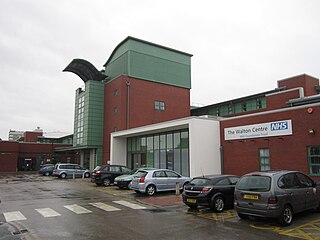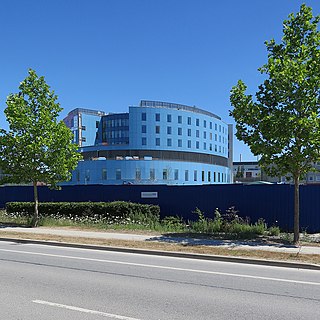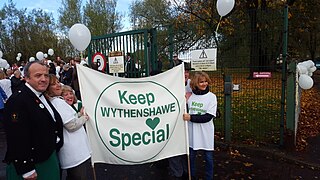
Sir Archibald Hector McIndoe was a New Zealand plastic surgeon who worked for the Royal Air Force during the Second World War. He improved the treatment and rehabilitation of badly burned aircrew.

A face transplant is a medical procedure to replace all or part of a person's face using tissue from a donor. Part of a field called "Vascularized Composite Tissue Allotransplantation" (VCA) it involves the transplantation of facial skin, the nasal structure, the nose, the lips, the muscles of facial movement used for expression, the nerves that provide sensation, and, potentially, the bones that support the face. The recipient of a face transplant will take life-long medications to suppress the immune system and fight off rejection.

The Walton Centre, formerly known as the Walton Centre for Neurology and Neurosurgery, is a major neurology hospital located in the suburb of Fazakerley in the city of Liverpool, England. It is one of several specialist hospitals located within the Liverpool City Region alongside Liverpool Heart and Chest Hospital, Alder Hey Children's Hospital, Liverpool Women's Hospital, Mersey Regional Burns and Plastic Surgery Unit and Clatterbridge Cancer Centre. The wards in the hospital are all named after pioneering neurosurgeons in the 20th and 21st century. It is managed by the Walton Centre NHS Foundation Trust.
St George's University Hospitals NHS Foundation Trust, formerly called St George's Healthcare NHS Trust, is based in Tooting in the London Borough of Wandsworth, and serves a population of 1.3 million across southwest London. A large number of services, such as cardiothoracic medicine and surgery, neurosciences and renal transplantation, also cover significant populations from Surrey and Sussex, totalling about 3.5 million people.

Blackpool Victoria Hospital, known locally as The Vic, is the main hospital for Blackpool and the Fylde Coast in Lancashire, England. It is managed by the Blackpool Teaching Hospitals NHS Foundation Trust.

Morriston Hospital is a 750-bed hospital located in Cwmrhydyceirw near Morriston in Swansea, Wales. It is managed by Swansea Bay University Health Board. Alongside its role as a district general hospital, Morriston is a teaching hospital for medical students of Swansea University Medical School.
Peter Edward Michael Butler, FRCSI, FRCS, FRCS (Plast) is Professor of Plastic and Reconstructive Surgery at University College London. He is consultant plastic surgeon and head of the face transplantation team at the Royal Free London NHS Foundation Trust in London, United Kingdom. He is Director of the Charles Wolfson Center for Reconstructive Surgery at the Royal Free Hospital, which was launched in November by The Right Honourable George Osborne, MP, Chancellor of the Exchequer at No 11 Downing Street in November 2013.

Royal Papworth Hospital is a specialist heart and lung hospital, located on the Cambridge Biomedical Campus in Cambridgeshire, England. The Hospital is run by Royal Papworth Hospital NHS Foundation Trust.
King's College Hospital NHS Foundation Trust is an NHS trust in London, England. It is closely involved with Guy's and St Thomas' NHS Foundation Trust, with which it shares its chair, Sir Hugh Taylor, its strategy director and IT director. It is assumed that the two organisations will eventually merge.

The University Hospital of South Manchester NHS Foundation Trust is a defunct NHS foundation trust that previously operated Wythenshawe Hospital, a major acute teaching hospital in Wythenshawe, Manchester. Many of the services and facilities previously at Withington Hospital were transferred to Wythenshawe in 2004. It provided services for adults and children at Wythenshawe Hospital and Withington Community Hospital. It runs Buccleuch Lodge Intermediate Care Unit and the Dermot Murphy Centre in Withington, and the Specialised Ability Centre in Sharston.

St John's Hospital is the main general hospital in Livingston, West Lothian, Scotland. Located in the Howden area of the town, it serves Livingston and the wider West Lothian region. St John's is a teaching hospital for the University of Edinburgh Medical School. It is managed by NHS Lothian.

East Lancashire Hospitals NHS Trust is an NHS hospital trust in Lancashire, England. It was established on 1 September 2002, as the result of a locally controversial, cost saving merger of Blackburn Hyndburn & Ribble Valley NHS Trust and Burnley Health Care NHS Trust, first announced in September 1999.

Guy's and St Thomas' NHS Foundation Trust is an NHS foundation trust of the English National Health Service, one of the prestigious Shelford Group. It runs Guy's Hospital in London Bridge, St Thomas' Hospital in Waterloo, Evelina London Children's Hospital, two specialist heart and lung hospitals, Royal Brompton and Harefield and community services in Lambeth, Southwark and Lewisham.

Crawley Hospital is a National Health Service hospital in Crawley, a town and borough in West Sussex, England. Since 2006 it has been part of the Sussex Community NHS Trust, which has overall management responsibility. Surrey and Sussex Healthcare NHS Trust also provides some services. The hospital is located in the West Green neighbourhood of Crawley, near the town centre.

Wexham Park Hospital is a large NHS hospital in Slough, Berkshire. It has been managed by Frimley Health NHS Foundation Trust since 2014. Sir Andrew Morris is the Trust's chief executive.
Raman Malhotra is a British ophthalmologist and oculoplastic surgeon. He is a consultant ophthalmic surgeon and head of the Corneoplastic unit, Queen Victoria Hospital, East Grinstead.
Sheraz Daya is a British ophthalmologist. Daya founded the Centre for Sight in 1996, and works in stem-cell research and sight recovery surgery.
Healthcare in London, which consumes about a fifth of the NHS budget in England, is in many respects distinct from that in the rest of the United Kingdom, or England.

The Liverpool Heart and Chest Hospital is a National Health Service hospital in Liverpool. It is one of several specialist hospitals located within the Liverpool City Region, alongside Liverpool Women's Hospital, Alder Hey Children's Hospital, the Walton Centre, Mersey Regional Burns and Plastic Surgery Unit, and Clatterbridge Cancer Centre. It is managed by the Liverpool Heart and Chest Hospital NHS Foundation Trust.

Mary Evelyn Lentaigne is a British former medical artist and Red Cross Voluntary Aid Detachment nurse who worked at the Queen Victoria Hospital, England, during the Second World War. She is known for the drawings she made there of the surgical procedures of New Zealand plastic surgeon Archibald McIndoe who was working on injured servicemen. Around 300 of her drawings are held by the East Grinstead Museum where they form the Mollie Lentaigne Collection.
















